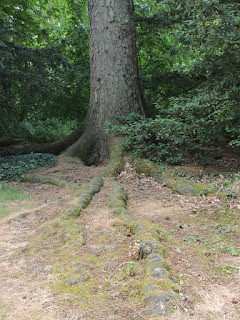From nappies to paper, from guitars to construction, this North American tree has become important to many facets of our lives. So much so, that the Forestry Commission is investigating how climate change will affect species such as this. They think that the Sitka may become restricted to wetter coastal or upland sites in the UK. It's also possible that higher levels of carbon dioxide could make plantations of Sitka more productive - as it stands there is a yield of 14 cubic metres per hectare per year from this species.
The Sitka/sitchensis is named for Sitka, Alaska on Baranof Island (which was the Russian Capital of Alaska at one time). Picea sitchensis was introduced to Britain by the plant hunter David Douglas in 1831 and can grow to 50 m with a trunk that has a diameter of 2 m. It has lovely needles and cones, but I have chosen it for this post for the fissures and flaky plates that make up the bark.
In a way the bark reminds me of pancake ice of the Antarctic (as seen on TV). I imagine for kids, that it's hard to resist giving these plates a bit of a tug to see if they'll come away from the tree! As the plates do fall away, some areas are totally smooth underneath, but some seem to leave wrinkled scars. I also quite like the patterns created by the roots that seem precariously shallow.
So, not only is this tree epic in terms of everything it does for us, but it's a beauty to go with it.
Resources:
Forestry Commission - Sitka spruce. 2015. Forestry Commission - Sitka spruce. [ONLINE] Available at: http://www.forestry.gov.uk/forestry/infd-5nlej6. [Accessed 02 November 2015].
Mabey, Richard. Flora Britannica. 1st edition. London: Chatto & Windus / Sinclair Stevenson, 1996.




No comments:
Post a Comment
I really enjoy reading and replying to your comments, but please do not use this space for advertising!